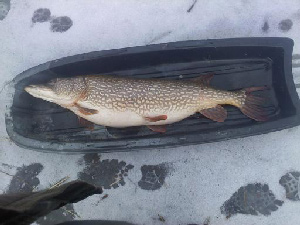Northern Pike
Esox lucius
 Distribution: Found in freshwater throughout the Northern Hemisphere including Europe and Asia. In North America, the northern pike ranges from Alaska and Canada south to Nebraska and Missouri, east of the Rocky Mountains and west of the Appalachian Mountains. It also inhabits Lake Champlain and the Hudson River drainage. Northern pike were introduced into the Connecticut River and a number of other waterbodies in New Hampshire. Their range in North America is expanding and introductions into new waterbodies are common.
Distribution: Found in freshwater throughout the Northern Hemisphere including Europe and Asia. In North America, the northern pike ranges from Alaska and Canada south to Nebraska and Missouri, east of the Rocky Mountains and west of the Appalachian Mountains. It also inhabits Lake Champlain and the Hudson River drainage. Northern pike were introduced into the Connecticut River and a number of other waterbodies in New Hampshire. Their range in North America is expanding and introductions into new waterbodies are common.
Description: The long, relatively thin body of the pike is olive-green to grey with white bar-like spots on the sides. The underside of the fish shades to pale yellow or white and fins are often marked with dark spots. They can be distinguished from pickerel by the absence of scales on the lower half of the opercle. The sizes to which they grow can be astounding with some fish reaching 50 inches and 40 pounds.
Species commonly confused with: Chain pickerel
Habitat: In rivers and streams, pike can be found in sluggish, cool water, while in lakes they prefer weedy or cold, clear, rocky areas. Spawning takes place in flooded marshes, small streams, and backwater coves. Juvenile fish prefer the cover of submerged plants or other structure.

Life History: Pike are early spring spawners beginning when water temperatures reach the mid-forties. In New Hampshire, these conditions sometimes occur before the ice has completely melted from a water body. Typically, eggs are scattered in flooded areas such as wetlands or grassy floodplains. Eggs hatch quickly, usually in about 12 to 14 days. The young use an adhesive gland on their heads to attach themselves to vegetation, where they remain inactive for 6 to 10 days as they feed on a yoke sac. The early spawning period gives juvenile pike a head start in growth so that they are large enough by late spring to feed on the larvae of other fish species. The swimming ability of male pike sperm becomes compromised in acidic waters, which limits the potential distribution of northern pike in New Hampshire. A pike must eat an estimated 5 to 6 pounds of food for each pound of growth in body weight. As northern pike reach maturity, they consume a stunning quantity of fish and other vertebrate prey, including frogs, crayfish, and waterfowl.
Origin: Introduced
Conservation/Management: Northern pike are managed primarily through season dates, size-limits, and daily bag limits. Illegal introduction into new water bodies may disrupt resident fish communities and impact other sportfish populations.



